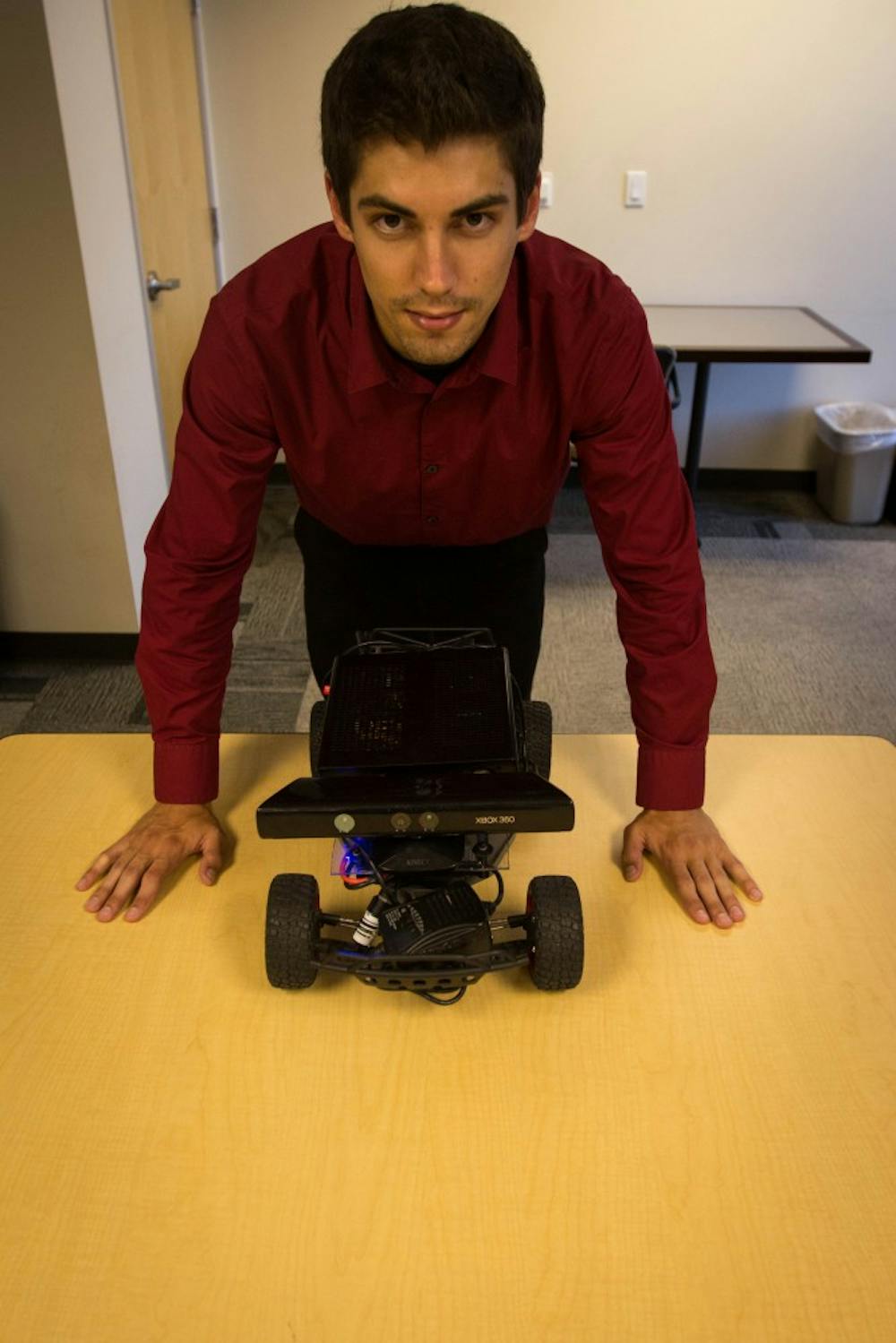 Cosmo the robotic car follows around an engineer who helped design him. Cosmo has been taught how to recognize voices and follow body motions. (Photo by Dominic Valente.)
Cosmo the robotic car follows around an engineer who helped design him. Cosmo has been taught how to recognize voices and follow body motions. (Photo by Dominic Valente.)Cosmo may look like a bunch of wires on wheels right now, but when it is finished, Cosmo will be every child's treasure and every parent's dream.
Born of a stripped down remote control car and the minds of computer engineering graduate students Edward Andert and Roger Dolan, Cosmo is a robot car that began as a class project but quickly became a valuable business venture.
"We entered the project into the engineering open house, and there were a lot of kids there," Andert said. "At one point, there was just a swarm of about 10 kids trying to play with it, and one of the biggest problems was that there wasn't more than one of these robots."
Andert said one parent approached him at the open house and asked him if Cosmo was for sale. When Andert told the parent that it wasn't, the parent replied that if it ever went on sale, he would be the first to buy it.
"He was all gung-ho about buying this thing because it isn't just something that you sit on the couch and play with or stare at a screen to use," Andert said. "It is a real life robot."
Andert, who remembers working with lego robots as a child, said he and Dolan soon realized this idea was bigger than just a class project and was "something that the world needs."
Dolan, who described Cosmo as "an entertaining and educational interactive robot toy," said he didn't envision himself working on robots when he began his education at ASU as an undergraduate, but he likes where the project is going.
 After fitting Cosmo with some final touches, Edward Andert stands over the robot in an office at the Brickyard on ASU’s Tempe Campus. Cosmo is still a prototype but will be finished “As soon as possible" according to Andert. (Photo by Dominic Valente.)
After fitting Cosmo with some final touches, Edward Andert stands over the robot in an office at the Brickyard on ASU’s Tempe Campus. Cosmo is still a prototype but will be finished “As soon as possible" according to Andert. (Photo by Dominic Valente.)"The final product will be different from anything we have ever seen before," he said. "I'm really looking forward to seeing what kind of games we can put into it and how it will interact with kids."
He said Cosmo is still in the "rough prototype" phase, and the team plans on making a second prototype, after which they will move on to the final product which would be available for parents to buy.
Aviral Shrivastava, the team's adviser on the project, said his 5-year-old daughter played with Cosmo for more than 30 minutes at the engineering open house and loved it.
When they got home, however, she asked her father a question that got the professor's wheels spinning.
"Can it stop if I ask it to stop?" his daughter asked.
"I started thinking, that makes a lot of sense," he said. "And I went back and told the guys, 'Can you put in some voice recognition?'"
He said that the project began as a merely a toy, but once he saw children playing with it, and his daughter reacting and asking him if it could play games with her, he realized its valuable educational potential. "We saw so many children playing with it and realized that this could be used to improve the learning and education of children," he said. "One of the holy grails is to make a toy that can both physically and mentally engage a child, and this combines those two things perfectly."
Cosmo now responds to the voice commands "Cosmo, follow" and "Cosmo, stop" and includes a video camera that will eventually have facial recognition capabilities.
Cosmo will also be able to play hide-and-seek as well as math and spelling treasure hunts, in which children are guided by Cosmo to a new location every time they solve a math or spelling problem, Shrivastava said.
The team is still exploring options for design and reliability as well as writing new code and deciding on which games to include, so Cosmo won't be available to the public for at least another year, Andert said.
Despite the long prototype process, he said the team is inspired and working rigorously.
Shrivastava said the team is constantly coming up with new ambitions for the final version of Cosmo, but there is one hurdle that they must overcome first.
"The major technical challenge that we are facing is getting this robot to be calibration agnostic so that we don't have to go in and set all the parameters all the time," Shrivastava said. "This robot will learn from the world it interacts with and calibrate itself."
Once the programming aspects are settled, Cosmo will receive a makeover by a design team, which Andert hopes will add to the appeal by making it look "a lot more childlike and more like a Disney character." Andert said the group hopes to continue making robots under the company name "Infinibotics."
"As far as the future of the company, we hope eventually that Infinibotics will spiral off into a bigger company, which makes robots to help out the elderly around the house or service robots," he said. "But that is down the road; right now Cosmo is something society needs, and we can do it with today's technology." Reach the reporter at npmendo@asu.edu or follow him on Twitter @NPMendoza




